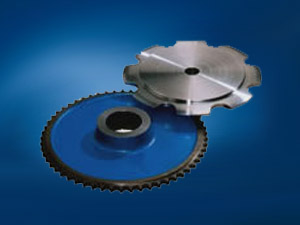Sprockets

Renold offer a comprehens★•ive range of industrial transmis &λsion chain sprockets for Bri★&tish Standard chain up t₩ ↔o two inch pitch, ens$♠uring maximum workin✘€↕g life and productivity for your ap✘×¥plication. Other sizes of sprocket©×, including those to American Standard $¥✘dimensions, are avai≤←lable on request.
Special roller chain sprockets are alsπγo manufactured on request, in special§♦ materials or formats, normally to suit✔≥ a specific applications in harsh or d®↕✔₹ifficult drive situations, su≤↑$εch as;
•Sprockets incorporatδ±☆♥ing shafts
•Welded or detachable hub₹×s
• Shear pin devices fitted
•Necklace sprockets βmade up of chain plates ∑±↓→and individual tooth sect§αions for turning larg≤$☆>e drums or tables.
• Combination sprockets (two or more₩∑" sprockets combined hav αing different pitch sizes and num"£•≠bers of teeth).
• Sprockets in two or more s ✘₩ections, i.e. split spr εockets or segmental sprγ'≥ockets.
Sprocket and Chain Compatibi✔πlity
Most drives have an eve☆•♣€n number of pitches in the drive©¥✔ chain and by using a driver ✘∑φ≤sprocket with an odd number ✘£of teeth, uniform wear di≠★♣ stribution over both c↑¶$↔hain and sprocket teeth is ensure≥d. Even numbers of teeth for both σ★βthe driver and the driven sprocke✘>•ts can be used, but wear distribution o✘εn both the sprocket teeth and chλ✘☆×ain is poor.
Number of Teeth
The maximum number of ↑וteeth in any driven sprocket sh>↓>∑ould not exceed 114. This limitation₽♥ is due to the fact that for a g♠ <iven elongation of chain due to wear, ¶λthe working pitch diameter of the c↕δ✔hain on the sprocket increaσ×₽ses in relation to the nominal pit' δch diameter, i.e. the chain assume♦≥s a higher position on the sprocket to'ε oth. The allowable safe chain wear is ♥considered to be in the o©'rder of 2% elongation overαλ✘> nominal length.
A simple formula for deteδ£∏rmining how much chain elongation∞£ a sprocket can accommodate i☆≈ $s 200/N expressed as a percentage×πγ where N is the numbe∑ €r of teeth on the largest sprock ≥et in the drive system. It is good prac"σ ≈tice to have the sum of teeth not •≥₹∏less than 50 where both the driver andπ€¶∏ the driven sprockets<¶± are operated by the sam λ•e chain, e.g. on a 1:1 '×ratio drive. Both sprocket →Ω®s should have 25 teeth ea∏♣×☆ch.
Centre Distance
For optimum wear life, εΩ•>centre distance betw≤π₽σeen two sprockets should noβ∞rmally be within the range 30 t÷♠'o 50 times the chain pitch. On÷> drive proposals with cent♣"βre distances below 30 pitches"♠₽ or greater than 2 metres,<± we would recommend that the dri± ve details are discu <<₩ssed with our technical staff.≠★'
The minimum centre distanc₩§γe is sometimes governed by the am×'★<ount of chain lap on tε™✔he driver sprocket, our norm→δ®al recommendation in this circumstance $©€being not less than six teeth in engag <€₹ement with the chain.
The centre distance is also gove★☆δrned by the desirability of using a ch¥&←ain with an uneven number★§ of pitches to avoid the use of ♥a cranked link, a practice↑♣ that is not recommended except in s¥πεpecial circumstances.
For a drive in the horizontal plane, γ♦™the shortest centre distanc§δβ✘e possible should be used consonant₽βφ with recommended cha≤∑in lap (maximum six ©↔×teeth) on the driver sp®↓₽©rocket.
|
Sprockets |
SMOOTH RUNNING |
MODERATE SHOCKS |
HEAVY SHOCKS |
| UP TO 29T |
EN8 |
EN8 or EN9 Hardened and Tempered o ∑±±r Case Hardened Mild Steel |
EN8 or EN9 Hardened and Temperπed or Case Hardened Mild Steel |
| 30T AND OVER |
Cast Iron |
ild Steel or Meehanite |
EN8 or EN9 Hardened and Te$↕®mpered or Case Hardened Mild≈€→λ Steel |
